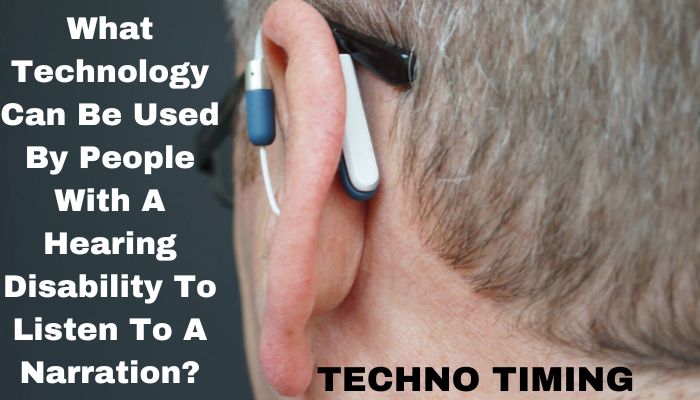A Guide for People with Hearing Disabilities Can Listen to Narrations Today!
Anyone who has a hearing disability in this day and age faces certain doom because of how dependent we are on technology. It becomes more difficult when you enjoy listening to music, audiobooks, and podcasts, but what if I told you there are solutions available to deal with hearing impairments?
The assistive listening technologies that make life easier for those with hearing loss are the topic of today’s blog. But let’s clarify before going any further:
What is a hearing disability?
When someone has hearing loss, they are unable to hear sounds. Any component of the hearing mechanism may have been damaged, developed improperly, or developed a disease. Your ability to hear relies on your proper speech and language development skills. A child picks up language by listening to how others in the family and their environment speak. An invisible impairment is deafness. Keen observation is necessary to identify a deaf person.
What are the types of hearing disabilities?
Conduction-Based Hearing Loss
Basically, conductive hearing loss means there’s an issue with the middle or outer ear. The inner ear does not effectively receive the sound. As a result, all sounds are weakened or muffled. Regardless of the background noise, such people typically speak softly.
Sense of hearing loss
Damage to or illness of the auditory nerve or inner ear are the two primary causes of sensorineural hearing loss. Additionally, it might be a side effect of contagious illnesses like measles, mumps, meningitis, and tuberculosis.
Uncertain Hearing Loss
Uncertain hearing loss has a mix of two different types of hearing loss going on at the same time. First is sensorineural hearing loss, which happens in the inner ear or auditory nerve, and second is conductive hearing loss when sound is not conducted very well through the outer ear canal to the eardrum. One of the major causes of this kind of loss is chronic suppurative otitis media (CSOM), an ear infection. CSOM is visible by ear discharge and resembles pus, blood, or clear water. Initially, conductive loss develops into sensorineural impairment if it’s not promptly and consistently treated.
Technologies to tackle Hearing Disability
Speech recognition technology converts spoken words (an audio signal) into command-applicable written text. Even the most cutting-edge software of today can recognize different accents and dialects.
ASR – (Automatic Speech Recognition)
Automatic Speech Recognition – ASR often appears in infuser-facing applications like virtual assistants, live captioning, and clinical notes. These use cases require accurate speech transcription. Developers in the speech AI industry refer to speech recognition using alternative terms like ASR, speech-to-text (STT), and voice recognition. ASR is a crucial part of speech AI, a set of tools that enables voice communication between people and computers.
TTS (Text-to-Speech)
Computers, smartphones, and tablets are just a few personal digital devices that text-to-speech (TTS) is compatible with. You can read any type of text file, including Word and Pages documents, and online web pages. It is possible to accelerate or slow down, and computer-generated voices that imitate children’s speech are available. Many TTS tools underline words that are said aloud. Kids can hear text while simultaneously seeing it due to this. An additional feature of some TTS tools is optical character recognition (OCR) technology. TTS tools can read aloud text from images thanks to OCR. Your child could, for instance, take a picture of a street sign and have the words on the banner read aloud.
Devices for an Individual with Impaired Hearing
Any device that facilitates communication for someone with hearing impairments can be an assistive technology. These terms frequently refer to tools that make it easier to hear and comprehend what is said or to communicate thoughts. As digital and wireless technologies advance, more and more tools are becoming available to support people with hearing, voice, speech, and language disorders in meaningful communication and full participation in daily life.
Assistive Listening Devices
Various ALD types can enhance sound transmission for those who have hearing loss. Some create ceilings for large buildings like theaters, schools, churches, and airports. Some are created for private use in intimate settings and for private conversations. These devices are all compatible with or without cochlear implants or hearing aids. Frequency-modulated (FM), infrared, and hearing loop systems are examples of ALD systems for big facilities.
FM Systems
FM systems use radio signals to transmit boosted audio. The teacher wears a small microphone clipped to a radio transmitter, and the student wears a receiver tuned in to the same frequency or channel. They are frequently used in classrooms. To transform the signal into magnetic signals that can be directly detected by the telecoil, people who have telecoils inside their hearing aids or cochlear implants may also choose to wear a wire around their neck or behind their aids or implants. FM systems can be used in many public locations and have a 300-foot signal range. To prevent receiving mixed signals, listeners in one room might need to tune in to a different channel than those in another because radio signals can pass through walls. Personal FM systems, which function similarly to larger-scale devices, enable people with hearing loss to follow one-on-one conversations.
Hearing loops (Induction loops)
Systems that use induction loops (hearing loops) transmit sound using electromagnetic energy. In a hearing loop system, there are four components:
- A sound source, such as a home TV, telephone, public address system, or microphone.
- An amplifier
- A small wire loop that surrounds a space or extends below carpeting.
- A headset or earpiece worn as a receiver.
Personal amplifiers
Personal amplifiers are handy when watching TV, being outside, or driving when the previous systems are absent. These gadgets, which are about the size of a cell phone, boost sound quality and lessen ambient noise for listeners. A speaker or other audio source can tilt toward some directional microphones. Like other ALDs, the amplified sound can be picked up by a receiver worn by the listener, such as headphones or earbuds.
Bottomline
Listening devices are tools for empowering people with hearing loss. They promote inclusivity in various settings and improve speech comprehension and sound quality. These technologies can change lives and eliminate communication barriers, whether hearing aids or assistive listening systems are used in public settings. The future of impaired technology appears bright with the advances in technology and the growing appreciation of the value of accessibility. We can continue to build a society that is more welcoming and supportive of people with hearing disabilities by embracing these cutting-edge devices.
Also Read: Unleash The Power Of Buying A Piece Of Technology To Become A Digital Citizen Today


